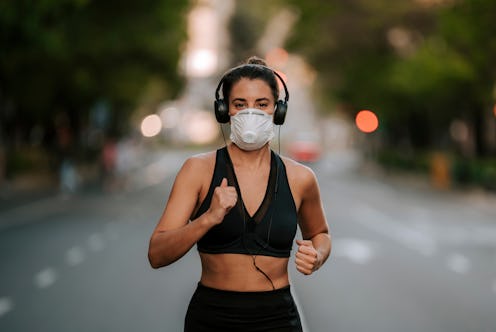(Living)
The Crucial Pro Tip That’ll Make Running With A Face Mask Easier

In addition to day-to-day work routines and social interactions (and life in general), for many, the recent pandemic has taken its toll on your fitness regimen. With the closing of gyms and workout studios across the country, everyone’s getting creative with how they get their exercise in. For some, that means taking sessions outside, whether that include long hikes, park yoga, or outdoor running. Or maybe you’re working out with a trainer or socially distanced group and wearing the required facial covering. Either way, these shifts beg the question: How does one work out with a face mask?
“Working out with a mask reduces our risk of contracting or spreading COVID-19, but also raises health concerns related to restricted airflow and how that affects our heart rate and brain during exercise,” says Brianna Bernard, Athlete and Personal Trainer for sports nutrition brand Isopure to The Zoe Report. “Studies have shown that doing the same exercise with a mask produced higher heart rates (by up to 10 beats per minute) than performing those same exercises without a mask. Due to air restriction, many participants in the study also felt light-headed and dizzy minutes into exercising with a mask, which they did not experience when the mask was not worn.”
Indeed, Nina Bausek, MSc, PhD Chief Scientist for PN Medical, confirms exercise, especially strenuous exercise, while wearing a face mask can have physiological consequences if one is not cautious. “Changes in the breathing pattern can cause imbalances in the O2/CO2 gas exchange, leading to either too low levels of CO2 (hypocapnia) or higher than normal levels of CO2 (hypercapnia),” says Bausek to TZR. “Exercise significantly increases CO2 and respirations will increase in order to bring the body back into balance. Changes in the gas exchange can affect the oxygen uptake and delivery to the tissue and the brain. Exercising muscles and the brain may not get sufficient oxygen to function properly and CO2 may not be excreted efficiently.”
That said, it’s still possible to work out safely and (somewhat) comfortably with your mouth covered — it simply comes down to a few precautions and details. “For the most part if you are healthy, you should be able to exercise safely while wearing a cloth or surgical mask,” says Bausek. “Keep in mind depending on the level of exertion, duration and environmental humidity, the mask may become saturated with your moist exhalations making it harder to breathe through. Also, if you are exercising outdoors and entirely alone, you may not need to wear a mask at all!”
To be clear, the Centers for Disease Control and Prevention (CDC), recommends staying at least six feet away from other people when out and about and wearing a mask to slow the spread of COVID-19. However, if you are working out alone in an open, outdoor space, the decision to wear a mask or not is up to you and should align with the guidance of the local public health authorities in your area or city.
Ahead, a few tips from health and fitness experts that will keep you and those around you safe while exercising with a face mask.
How To Work Out In A Face Mask: Take Breaks
If your workout is particularly strenuous (here’s looking at you, long-distance runners), it’s wise to hit the pause button here and there, and take a few mask-less breaths (if it’s safe to do so and you’re not near anyone). “If exercise with a face mask is necessary, frequent breathing breaks without the mask are a good idea, especially when the perceived work of breathing increases,” says Bausek.
How To Work Out In A Face Mask: Choose Your Mask Wisely
"I think the key to successfully working out with a mask on is to find the right mask," says Alissa Tucker, Master Trainer for fitness studio AKT. "I’ve had the most luck with masks that have a seam down the center so it sits slightly away from the face. I’ve been using the Jaanuu masks, which are antimicrobial and allow enough space for my breath to circulate under it. I also think it’s important to have a dedicated exercise mask that you wash between workouts."
From a medical standpoint, Bausek says she recommends "surgical masks, cloth masks, or those made of wicking materials."
How To Work Out In A Face Mask: Adjust Your Breathing Pattern
"When wearing a mask is necessary, taking five quality breaths before putting on a mask, after putting on a mask, and after taking off the mask can help to maintain a good breathing pattern while wearing a mask, and reduce the symptoms caused by incorrect CO2 levels in the body,” explains Bausek. “A quality breath is defined as a nasal inhale for four seconds, a six-second exhale through the mouth followed by a two-second pause.”
How To Work Out In A Face Mask: Adjust Your Workout
“Modify your workouts in a way that allows for less HIIT or essentially, more recovery between sets/intervals,” says Steve Stonehouse, NASM, CPT, and Director of Education for indoor running studio franchise STRIDE. “This can ease the overall breath stress throughout the workout and make it more manageable.”
Bernard advises saving intense workout sessions for outdoors “when physical distancing can be practiced and masks do not need to be worn. When exercising indoors, stick to low to moderate intensity workouts like yoga or weight lifting, to avoid airflow restrictions.”
This article was originally published on